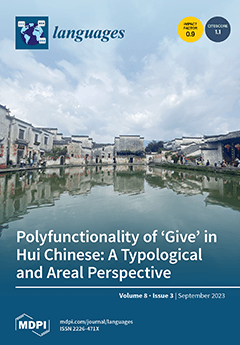Japanese society’s traditional gender norms are reflected by sentence-final particles (SFPs) in daily conversation. However, recently, Japanese young people have started to use gendered SFPs in “unclassical” ways. This study mainly examines the usage of the so-called “female” SFPs
wa and
no by
[...] Read more.
Japanese society’s traditional gender norms are reflected by sentence-final particles (SFPs) in daily conversation. However, recently, Japanese young people have started to use gendered SFPs in “unclassical” ways. This study mainly examines the usage of the so-called “female” SFPs
wa and
no by male speakers. In total, 68 cases of
wa (43 by male speakers and 25 by female speakers) and 84 cases of
no (47 by male speakers and 37 by female speakers) usage were collected from casual conversations of Japanese college students in
TalkBank, a public linguistic database. This study demonstrates that the “female” SFPs
wa and
no are used more frequently by male speakers than by female speakers. Different from the female speakers’ usage to soften the utterances and enhance conversational rapport,
wa and
no used by male speakers perform other functions. In particular,
wa directly indexes self-centeredness, serving the speaker to express emotion, share personal ideas, or perform speech acts such as teasing or
amae in a self-focused way, while
no directly indexes truthfulness, which allows the speaker to share a story in a vivid tone, reconfirm the speaker’s prior statement, or provide the speaker’s explanation/reasoning in an assertive tone. This study suggests that the new, unconventional gender-based usages of SFPs reveal the social changes in gender dynamics in modern Japanese society, which should not be overlooked in language education.
Full article





